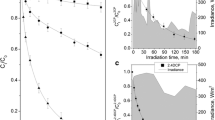Abstract
The photodegradation of phenol was studied in a batch reactor system illuminated with a 400 W medium pressure mercury lamp. The effects of parameters such as pH, reaction time and initial phenol concentration on the photolytic degradation and toxicity assay have been studied. The experimental results have shown that lower pH and lower concentration of phenol favor the phenol degradation. The disappearance of phenol in each case approximately obeyed first-order kinetics with the apparent rate constants increasing with decreasing solute concentration. Bioassay tests showed that phenol was toxic to Daphnia magna and so resulted in quite low LC50 values. Comparison of toxicity units (TU) between phenol and effluent toxicity has shown that TU value for effluent was 2.18 times lower than that obtained for phenol. Thus, photolysis is able to decrease the toxicity of by-products formed during the degradation of phenol.
Similar content being viewed by others
Author information
Authors and Affiliations
Corresponding author
Rights and permissions
About this article
Cite this article
Mahvi, A., Maleki, A., Alimohamadi, M. et al. Photo-oxidation of phenol in aqueous solution: Toxicity of intermediates. Korean J. Chem. Eng. 24, 79–82 (2007). https://doi.org/10.1007/s11814-007-5013-4
Issue Date:
DOI: https://doi.org/10.1007/s11814-007-5013-4




